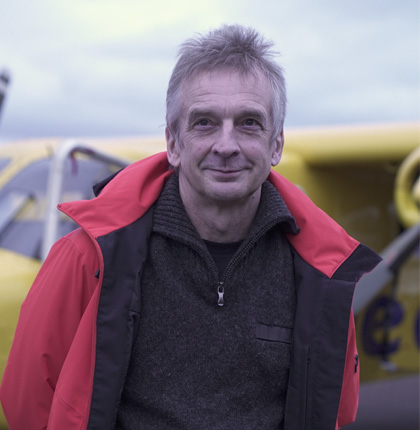I study the interaction between the air and the planet surface, and the relationships between vertical profiles and turbulence. I focus on the stratified Atmospheric Boundary Layer (ABL) as this is still poorly described in global or regional models due to complex feedback systems within the flow.
During my first Antarctic winter in 1986 I noticed that the turbulent atmosphere during the polar night is more complex than expected, with a variety of coherent structures apparent in fine resolution data from acoustic radar and sonic anemometers. The mechanism that generates and maintains these structures when the atmosphere is stratified (stable) but turbulent is still obscure; turbulence should act to diffuse or blur any structure, not enhance them.
Understanding this effect is of growing importance in improving the accuracy of our climate models, as parameterization schemes that derive surface fluxes from bulk meteorology are very noisy and on average biased.
My personal research still dwells in the Stable ABL, working through an international group within GEWEX trying to improve GCMs in this area by understanding the missing physics. Click here for micrometeorological data from the Halley Instrumented Clean Air Sector from 2003 to present.
In the later decades of the 20th century, ABL research focused on improving global circulation models, in order to better understand the earth climate system. More recently the growing urgency for efficient renewable eneger, especially from wind, is encouraging a more pragmatic development of ABL modeling, and with it the need for applied techniques to gather in situ validation data: not a trivial task in the marine environment.
As a direct result of the need for in situ ABL data, I am closely involved with the development of Remotely Piloted Aircraft Systems (also known as UAVs): I use a variety of UAVs, both for my own in situ atmospheric research, and to assist other science groups within SAMS and elsewhere to gather specialist terrestrial and ocean observation.
Current research
Arctic ABC Development. Funded by the Norwegian Science Foundation. 2015-
ShellEye. Funded by NERC/BBSRC. 2017-19
PRIMROSE. Funded by EU Interreg Atlantic Arc. 2017-20
Past highlight projects
FOCAS: First flight of unmanned aerial vehicles in Antarctica. Funded by NERC. 2005-10
OFCAP: Identification of the mechanism for the melting of the Larsen Ice Shelf. Funded by NERC. 2009-12
Ruiz-Villarreal M, Sourisseau M, Anderson P, Cusack C, Neira P, Silke J, Rodriguez F, Ben-Gigirey B, Whyte C, Giraudeau-Potel S, Quemener L, Arthur G, Davidson K. (2022) Novel Methodologies for providing in situ data to HAB Early Warning Systems in the European Atlantic Area: The PRIMROSE Experience. Frontiers in Marine Science 9: 791329 https://doi.org/10.3389/fmars.2022.791329
Anderson PS (2012) Climatology of tropospheric solitary waves observed over an ice shelf. In: Kooij-Connally E (ed). Workshop on Diurnal cycles and the stable boundary layer. ECMWF, Shinfield Park, Reading, UK.
Anderson PS (2009) Measurement of Prandtl Number as a Function of Richardson Number Avoiding Self-Correlation. Boundary-Layer Meteorology. 131(3):345-362.
Jones AE, Anderson PS, Begoin M, Brough N, Hutterli M, Marshall GJ, Richter A, Roscoe HK and Wolff EW (2009) BrO, blizzards, and drivers of polar tropospheric ozone depletion events. Atmospheric Chemistry and Physics. 9:4639-4652.
Anderson PS and Neff WD (2008) Boundary layer physics over snow and ice. Atmospheric Chemistry and Physics. 8(13):3563-3582.
Anderson PS and Bauguitte SJB (2007) Behaviour of tracer diffusion in simple atmospheric boundary layer models. Atmospheric Chemistry and Physics. 7(19):5147-5158.
Jones AE, Wolff EW, Salmon RA, Bauguitte SJB, Roscoe HK, Anderson PS, Ames D, Clemitshaw KC, Fleming ZL, Bloss WJ, Heard DE, Lee JD, Read KA, Hamer P, Shallcross DE, Jackson AV, Walker SL, Lewis AC, Mills GP, Plane JMC, Saiz-Lopez A, Sturges WT and Worton DR (2008) Chemistry of the Antarctic Boundary Layer and the Interface with Snow: an overview of the CHABLIS campaign. Atmospheric Chemistry and Physics. 8(14):3789-3803.
Saiz-Lopez A, Plane JMC, Mahajan AS, Anderson PS, Bauguitte SJB, Jones AE, Roscoe HK, Salmon RA, Bloss WJ, Lee JD and Heard DE (2008) On the vertical distribution of boundary layer halogens over coastal Antarctica: implications for O-3, HOx, NOx and the Hg lifetime. Atmospheric Chemistry and Physics. 8(4):887-900.
Simpson WR, von Glasow R, Riedel K, Anderson P, Ariya P, Bottenheim J, Burrows J, Carpenter LJ, Friess U, Goodsite ME, Heard D, Hutterli M, Jacobi HW, Kaleschke L, Neff B, Plane J, Platt U, Richter A, Roscoe H, Sander R, Shepson P, Sodeau J, Steffen A, Wagner T and Wolff E (2007) Halogens and their role in polar boundary-layer ozone depletion. Atmospheric Chemistry and Physics. 7(16):4375-4418.
I joined SAMS in the summer of 2012 as Head of Marine Technology after 27 years working at the British Antarctic Survey (BAS). I started at BAS as a field scientist and instrument designer, spending two austral winterers (1986 and 1991) at the Halley Research Station in the south Weddell Sea, and accumulated a further three years “south of the circle” during summer seasons. I gained my Ph.D. in 1994 on stratified atmospheric boundary layers.
In the 1990s I developed a number of techniques to probe the winter-time polar atmosphere, including low-power autonomous remote systems at the surface and kite, blimp and rocket instrument platforms aloft. In the last 10 years, I have concentrated on the physics of coherent structures in the stable boundary layer, whilst developing the use of small robotic aircraft for measuring the structure of the atmosphere near the surface. At SAMS these techniques help us understand sea-ice dynamics in the Arctic and explain the observed dramatic reduction in summer-time sea-ice coverage.
Employment history
Since 2012 Senior Lecturer. SAMS
2009-12 Boundary-layer physicist within CLIMATE Programme. British Antarctic Survey
2005-08 Project leader for UAS-based research and analysis of APACE data. BAS
2000-05 Project leader for Surface Processes Affecting Antarctic Climate. BAS
1995-2000 Project leader for FLUX project monitoring full surface energy balance. BAS
1994 Promotion to Senior Scientific Officer / PB5
1988-94 Open-ended appointment as physicist, including 1991 winter at Halley Stn. BAS
1985-89 Joint BAS as wintering scientist for the Stable Antarctic Coundary Layer Experiment
1983-85 Instrument technician and lecturer. People's College, Nottingham
